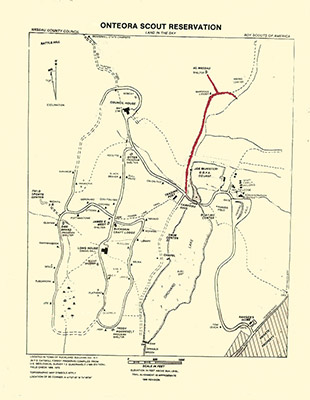
With the Chiefs and Tribes Camps out of the way, it's time to head towards the final section of Onteora, Buckskin Camp. The small map on the right shows the road through Buckskin Camp highlighted in red to give you an idea of the area; click on the map for a larger version.
We'll start this part of the tour back down at the lake, right in front of the Trading Post. If you had just come down the hill from the main part of camp, you would be turning left onto the road towards Al Nassau Shelter on the map.
This road parallels Sprague Brook, the stream that feeds Orchard Lake. This is one of the prettiest parts of Onteora, with a number of small ponds and grassy areas. This was once a busy trout fishing stream, and many of the ponds were man-made for this purpose. I remember earning my Water Conservation merit badge in 1965 by helping clear out some of these ponds, which had become clogged by silt, rocks, and weeds. It was tough work, with lots of hauling of dirt and rocks, but the results were well worth it. Years later, even as late as 1988, the ponds were clear and trout could still be found. I understand that the ponds are continuing to fill with silt and that trout are now hard to find, but it's still a pretty area and full of photo opportunities.
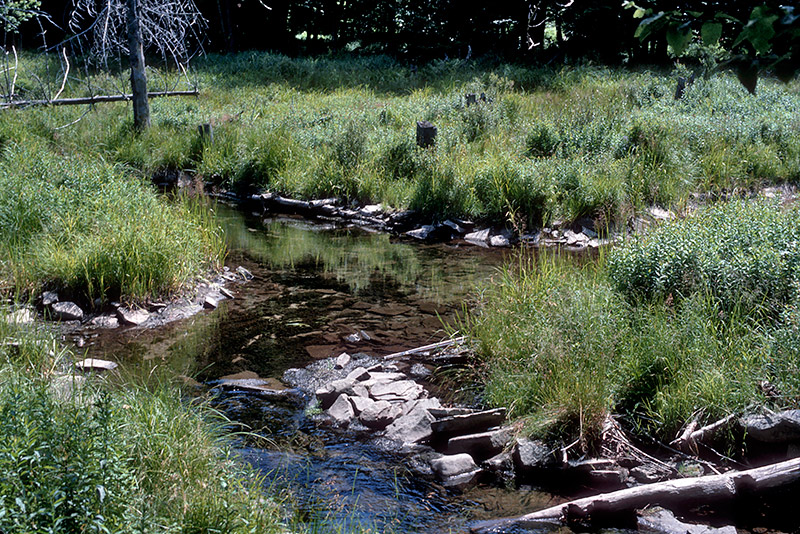
Sprague Brook (1983)
The Catholic Chapel was along this road, about where the Joe Munisteri C.O.P.E. Course is seen on the map. This was perhaps the most attractive of the three chapels, for you entered it by crossing over the stream on a small bridge. The gentle gurgling of the passing water lent a nice touch to the outdoor ceremonies. You can't tell today that a chapel ever stood there, for the structure was moved behind the Health Lodge for use as staff housing, and all other signs have long vanished. The chapel building is totally gone now, as it fell into disrepair and was demolished several years ago. Joe Munisteri was a Council board member and an executive at a power company, and he arranged for the donation of the poles. C.O.P.E. stands for "Challenging Outdoor Personal Experience", a BSA mountaineering program.
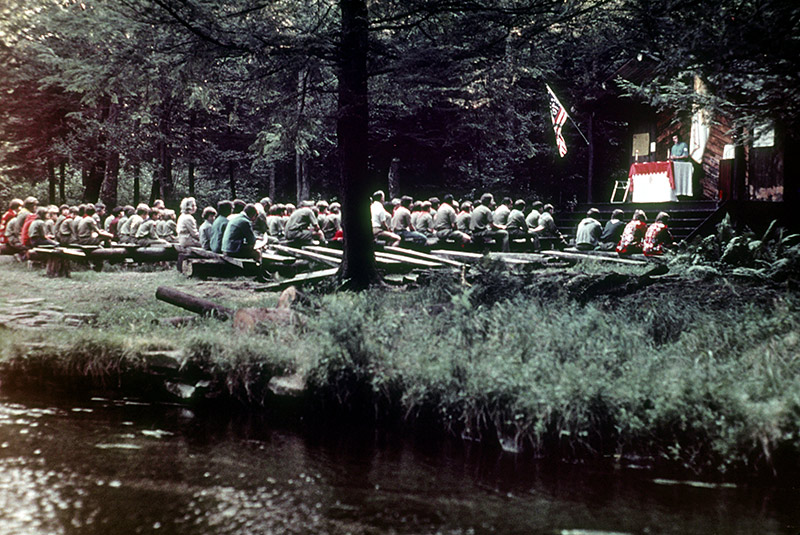
Catholic Chapel (1970s)
Continuing on the road brings you to a section known as the "washboard". This is a series of fairly regularly spaced ruts in the road, seemingly designed to rip apart any passing vehicle. No matter how hard the maintenance staff worked to fill in the ruts with loads of dirt and rocks, the road would quickly revert back to the washboard condition. As this was one of the longest straight-aways in the camp, I guess it was nature's idea of speed bumps.
After surviving the washboard and passing through a large meadow you'll come to the Al Nassau Program Shelter. Information on this long-time Scouter can be found in the Buckskin Tab published by the Order of the Arrow. Off to the right the map shows a Hiking Center, another addition since I worked there. I couldn't find any sign of it during my 1998 visit, despite walking right through the area. The meadow area is a real challenge to hike through today, for it's overgrown and the plants, whatever they are, are about five feet high. To make it even more fun, the ground is rutted and in some spots, more than a bit damp.
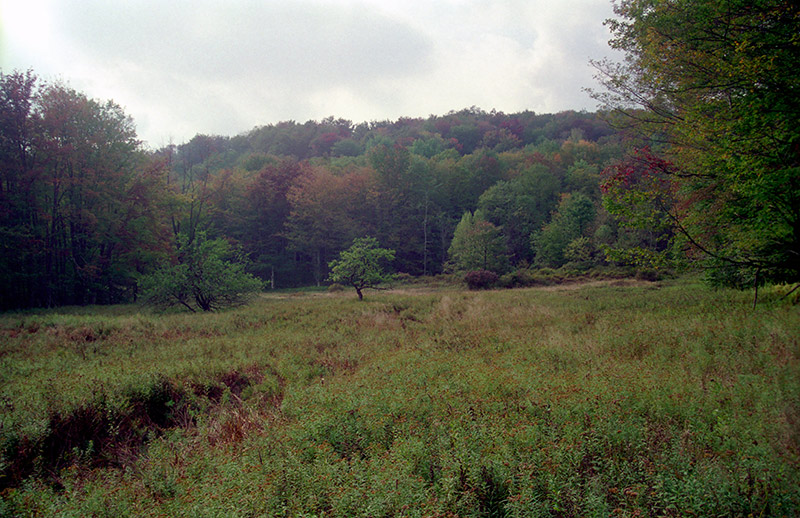
Buckskin Camp (1998)
Where then, you might ask, is the rest of Buckskin Camp? Where are the campsites and the dining hall? Well, that leads to an explanation of the camp that never was.
When attendance at Onteora started booming in the 60s, the camp simply could not accept any more campers in the Chiefs and Tribes Camps. Every existing campsite was used, and new ones like the hapless Yo-Kuts were added to meet the demand. When even this wasn't enough, it was decided to build a third camp, to be named Buckskin Camp or Buckskin Division. This camp, to be funded in large part through the efforts of the local Order of the Arrow Lodge, Buckskin Lodge #412, was to have its own dining hall and waterfront just like the other camps.
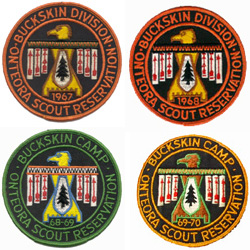
Patches sold to fund Buckskin Camp
Work began on Buckskin Camp in the mid-60s by placing campsites along the road we just traveled down and with the construction of Al Nassau Shelter. Some of these campsites were just as miserable as Yo-Kuts; I have a number of pictures of those next to Sprague Brook showing what happened when the brook overflowed in 1969. The campers in these sites also had quite a hike to their meals in the Council House, as can be seen on the map. One of the docks from Camp Wauwepex was brought up to Onteora, and it looked like Buckskin Camp was soon to be a success.
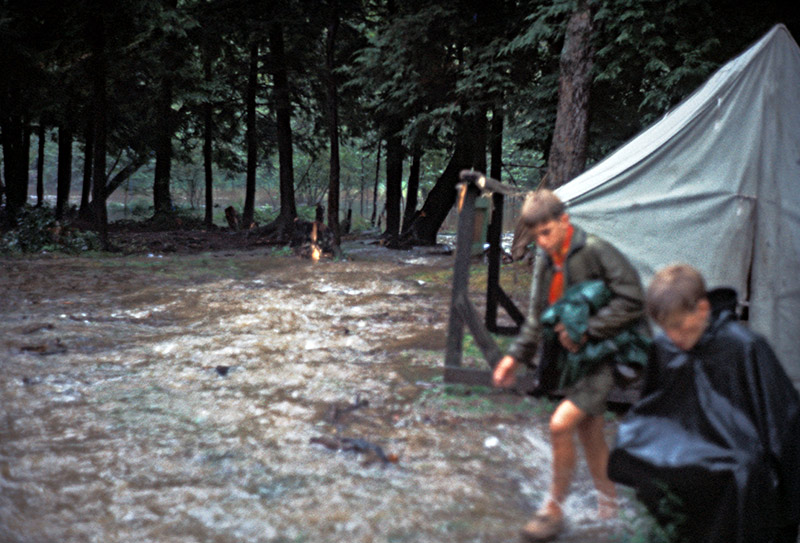
Johnny Appleseed campsite (1969)
Unfortunately, when Scouting suffered a dramatic drop in the number of boys enrolling in the program, Buckskin Camp was doomed. You have to wonder today if the Scout executives back then had ever looked at the demographics that clearly showed the days of the "Baby Boomers" were drawing to an end, making it unlikely that enrollment would continue unchecked, or that other factors would lead to a reduced interest in Scouting. Apparently not. Attendance at Onteora plummeted, and by 1983 any hopes of building the dining hall or more permanent campsites was abandoned. Soon, the future of all of Onteora would be in doubt.
Other than the brief period of camp overflow, Buckskin Camp never came to be. The name lives on, though, for the Council adopted the term "Buckskin Camp" to mean camping without meals in a dining hall, a tradition that continued with the rebirth of Onteora for the 1998 camping season.
That concludes your tour of Onteora! I hope that it re-awakened some fond memories for past campers and counselors. Please head back to the main Onteora page for more information on programs at the camp, including visits to the other Nassau County Council camps, Alder Lake Scout Reservation and Camp Wauwepex, or use the menu at the top of the page to explore more of the site.